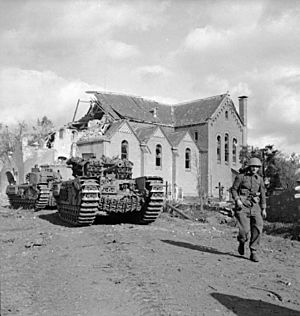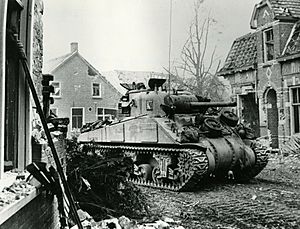Battle of Overloon facts for kids
Quick facts for kids Battle of Overloon |
|||||||
|---|---|---|---|---|---|---|---|
| Part of World War II | |||||||
 Churchill tanks with infantry advance during the attack by 3rd Division on a German pocket near Overloon, 14 October 1944. |
|||||||
|
|||||||
| Belligerents | |||||||
| Commanders and leaders | |||||||
| Strength | |||||||
| 2 divisions | 107th Panzer Brigade, Fallschirmjäger units | ||||||
| Casualties and losses | |||||||
| 1,878 men 3 aircraft 40 tanks |
600 infantry unknown number of tanks |
||||||
The Battle of Overloon was a tough fight during World War II in the village of Overloon, Netherlands. It happened from September 30 to October 18, 1944. Allied forces fought against the German Army. The Allies won this battle. They then freed the nearby town of Venray. This battle was part of a bigger plan called Operation Aintree.
Contents
Why the Battle Happened
In September 1944, the Allies started a big plan called Operation Market Garden. Their goal was to cross the Rhine river and get around Germany's strong defenses, the Siegfried Line. This would help them push towards Berlin.
However, Allied airborne troops were stopped at Arnhem. This left a narrow strip of land, like a finger, reaching into the Netherlands. This area was called a "salient."
German forces then attacked this salient. They had a strong position west of the Meuse river, near Venlo. This area was hard to attack because it had bogs (swampy areas) and canals.
The Allies decided to attack the German position from the north. To do this, they needed to capture Overloon and Venray. These towns were on the main road to Venlo.
Operation Aintree
The battle of Overloon was part of Operation Aintree. This operation had two main goals. First, it aimed to make the Allied "salient" safer. Second, it wanted to destroy the German position west of the Meuse river. This was important for the Allies to advance into Germany later.
The Battle Begins
The battle started when Allied troops moved south towards Overloon. The U.S. 7th Armored Division tried to capture Overloon first, but they were not successful.
Then, the British 3rd Infantry Division and the British 11th Armoured Division took over the attack. The U.S. 7th Armored Division moved to a different area. They made attacks there to distract the German forces.
Fighting in Overloon and Venray
The British forces faced heavy fighting. They captured Overloon, but the village was completely destroyed. They then moved towards Venray.
The advance on Venray was very difficult. Many soldiers were lost, especially near the Loobeek creek. This creek was flooded and mined by the Germans. The 1st Battalion, Royal Norfolk Regiment suffered many losses here.
About 2,500 soldiers died in and around Overloon. This made it one of the deadliest battles in the Netherlands during World War II. Many tanks, mostly American, were also destroyed.
What Happened After
Even though Overloon and Venray were captured, the Allies stopped their advance towards Venlo. They had lost too many soldiers and needed troops for other important tasks.
They had to secure the Scheldt estuary, which led to the important port of Antwerp. They also needed to secure the western part of the North Brabant province.
The offensive eventually started again. By early December 1944, the German position west of the Meuse river was destroyed. Blerick (near Venlo) was freed in December 1944. Venlo and other areas east of the Meuse were freed on March 1, 1945.
Remembering the Battle
The Battle of Overloon is sometimes called the "forgotten battle." This is because it is not as well-known as other battles in the Netherlands. It was also known for its fierce fighting, like the Battle for Caen.
Museums and Memorials
After the battle, many tanks and other military vehicles were left behind. These have been saved. In 1946, a museum opened in Overloon to remember the battle.
Today, this area is called Liberty Park. It has two museums:
- The National War and Resistance Museum of the Netherlands tells the story of the Dutch experience during the war.
- The Marshall Museum has a collection of tanks, weapons, and aircraft from World War II. Many of these were found on the Overloon battlefield.
Two memorials also stand at the battle site:
- The Norfolk monument is by the Loobeek creek. It honors the 1st Battalion of the Royal Norfolk Regiment.
- Another memorial is located in the museum grounds of Liberty Park.
The text on the memorial at Liberty Park says: English translation: TAKE PAUSE FOR A MOMENT visitor, and consider that the ground you are now on was once one of the most fiercely contested sectors of the Overloon battlefield. Bitter hand-to-hand combat ensued here. Many young lives, having escaped from the battlefields of Nettuno and Normandy, met their ends under these trees.
Images for kids
See also
- Overloon War Museum
- Kenneth Mayhew




